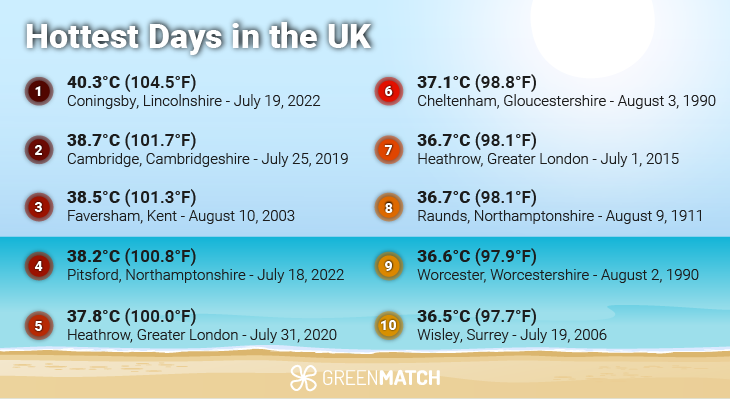- GreenMatch
- Blog
- When is the Next UK Heatwave?
When is the Next UK Heatwave?


Well known for our cold, wet weather, the UK isn’t somewhere you normally think of when you hear ‘heatwave’. However, this has changed in recent years, as record-breaking temperatures are becoming increasingly common across the country.
In July 2022 the UK experienced its hottest summer lasting from June to August, with its hottest day ever surpassing temperatures of 40°C for the first time in known history. Furthermore, early 2025 has seen temperatures that continue to rise. So far, during April the warmest day of the year was recorded at 24 °C.
While many of us enjoy a break from the dull weather, this intense change to our climate isn’t all good news. Such high temperatures can be life-threatening, and with predictions that heatwaves may become even more frequent, it’s time we took a closer look at this phenomenon.
In this article, we’ll explore why Britain is experiencing such high temperatures and what’s changed since the early 2000's? And can we do anything to prevent or prepare for even more heatwaves?
Are UK heatwaves on the rise?
It’s no secret that we Brit’s love a bit of sunshine - it’s usually rare! But since the early 2000’s we’ve experienced more scorching days, and more commonly, we’re hearing the term ‘heatwave’ each summer.
The Met Office (the UK’s weather experts) define a heatwave as a period of at least 3 consecutive days which meet or exceed a given threshold based on location - for example, 25°C. They can last from a few days to a few weeks and are considered an extreme weather event.
As seen below, in the top 10 hottest recorded days, our temperatures have been rapidly rising throughout the summer months, year on year.

Although 2022 still holds the record for the hottest day ever in the UK, data in recent years has shown that this was not a one-off event, but part of a trend in rising temperatures.
For example, 2023 was the UK’s second warmest year on record, with an annual mean temperature of 9.97°C. A remarkable feature was the September heatwave, which broke records, with temperatures reaching 30°C for an entire week -unexpected conditions for so late in the year.
Additionally, while 9.97°C seems very low, it’s essential to comprehend that this number indicates the standard temperature of the whole year, even the colder winter nights. Due to this, small increases in the average temperature are notable, and almost 10°C is very unusual for the UK, considering its long-term average temperature stands closer to 9.1°C.
On September 9th 2023, Kew Gardens in London hit 33.2°C, marking the hottest day of the year and the second-warmest September day ever recorded. June 2023 was also the hottest June on record, with temperatures recorded above 25°C for over two weeks, reaching highs of 32.2°C.
This warm weather continued into 2024, which ranked as the UK’s fourth warmest year with an annual average temperature of 9.78°C. The year’s highest temperature, 34.8°C, was measured in Cambridge on August 12th during a short but intense heatwave.
Moreover, 2025 has already seen unusual high temperatures. March was the UK’s sunniest March since records began in 1910. During April, Hampshire recorded highs of 23.7°C, with forecasts suggesting temperatures could reach 29°C by the end of the month.
Meteorologists have described this recent warm spell as “markedly high”, hinting that 2025 could once again see record-breaking conditions.
So, why is this happening? To put it simply, climate change is the cause. Driven by human activity that produces greenhouse gases.
These gases (such as carbon dioxide, methane and nitrous oxide), are created every time we burn fossil fuels (like gas or oil) to drive our cars or power our homes. Deforestation, farming, waste landfills and pollution are also major contributors.
As greenhouse gases continue to enter Earth’s atmosphere, they trap the sun’s heat, warming the planet. As time passes, we see the impact of this excess heat as it starts changing our climates.
For the UK, climate change is experienced in both extremes of hotter, drier summers and much wetter winters. Storms and floods are more frequent due to rising sea levels driven by warmer oceans. Our winters are milder, so we see more rain and less snow.
It’s predicted that by 2070, UK summers could be up to 4.9°C hotter, and winters could warm up by 3.9°C. On the surface, this doesn’t sound so bad. Still, things begin to get more serious when you consider the knock-on effect these weather changes have on our natural environment, animals and plants and ultimately our food supply.
Should we be concerned about heat waves?
In 2022, the top temperature recorded in the UK was 40.3°C. Research states that the human body starts to struggle when trying to adjust to increased temperatures and uses more energy to stay cool. Once it gets between 40°C and 50°C, the body no longer functions effectively.
According to research, one in five people in the UK has faced health problems caused by extreme heat over the past five years. In 2022, England recorded the highest number of heat-related deaths ever. More than 4,500 people died due to high temperatures.
During the summer of 2024, there were over 1,000 deaths due to the severe heat, mostly among elderly people aged 85 and over. This highlights how dangerous heatwaves can be, as they increase the risk of dehydration, heatstroke and heart failure. The elderly and those with pre-existing health conditions are the most vulnerable.
News that another global temperature record has fallen is a reminder of the risk the UK faces from extreme heat. If we fail to prepare, many more vulnerable people will suffer preventable deaths before this decade is out.
The risk to life increases in the UK when temperatures rise above 22°C. Considering all of the hottest temperatures in recent years are reaching far above this, it’s clear that we need to be taking heatwaves seriously.
Heatwaves are known as "silent killers," particularly affecting vulnerable groups such as the elderly, those with pre-existing health conditions, and isolated individuals. The risk of heat-related illnesses like dehydration, heat exhaustion, and heatstroke is expected to increase.
To better prepare for future heat waves, the UK Health Security Agency has created a ‘heatwave plan’ to reduce the risk of severe heat for yourself and others. You can also read our guides to help you keep your home cool and find out when to open windows in hot weather.
Can we prevent heatwaves in the UK?

As we’ve seen, heat waves are directly caused by human activities that increase the global temperature. If we want to change their frequency or intensity, we need to reduce our global impact.
Although this change won’t happen overnight and requires a dedicated global effort, we can make a difference individually. By adopting a more eco-friendly approach to our daily activities, we can live more sustainably and reduce our environmental impact.
Here are just some things you could do to make a difference:
-
Reduce. Reuse. Recycle:
Reduce household waste by reusing, repurposing, or recycling items. Choose secondhand items over brand-new ones, and donate your unwanted items.
-
Switch to renewable energy sources:
You could install solar panels to produce electricity or replace a fossil-fuelled gas boiler with a low-carbon air source heat pump. Air source heat pumps can also be used in reverse for air cooling as a type of air conditioning.
-
Think about transport:
Opt for public transport or cycling, or consider an electric vehicle to reduce emissions.
-
Adaptation:
Upgrading buildings to have better ventilation and insulation. Develop contingency plans for power outages, wildfires and other potential risks that can be caused by extreme heat.
Are you ready to beat the heat and embrace a sustainable future? Don't wait for the next heat wave to catch you off guard. Take action now and enjoy a cooler, greener home tomorrow.
When is the next heatwave in the UK?

We all know that weather forecasts are not always accurate. The day you choose not to take your brolly is inevitably the day it rains! But the experts are usually good at predicting the likelihood of big weather events like heat waves.
According to the Met Office, weather forecasts for heatwaves can be predicted up to a week in advance. However, due to the nature of our constantly shifting atmosphere, forecasts are most accurate the smaller the time frame (i.e. a day or two before), so it’s not possible to know months or years ahead of time.
However, the experts have predicted future weather conditions based on current and historical data. One such prediction states:
By 2070, the chance of exceeding 30°C for two days or more throughout the year increases. Projections show that exceeding 30°C for two days or more over southern parts of the UK becomes sixteen times more frequent than it is today.
It’s hard to know when exactly our next heatwave might arrive, but with our recent temperature record, it’s safe to bet that future UK weather forecasts won’t be cooling down soon.
What’s the future for UK weather?
While the entire UK is set to feel the heat, some areas will be turning up the thermostat more than others. Southeast England is expected to be the hotspot, with temperatures potentially outdoing those in some holiday destinations.
The UK’s weather pattern is changing rapidly, and it’s clear to see how climate change affects our temperatures. As our planet warms, we see more frequent and severe heat waves and, human activities are primarily responsible for this change.
As temperatures rise, the risk to life increases, and it’s crucial that we make efforts now to reduce our environmental impact. By choosing renewable alternatives and avoiding actions that release greenhouse gases, we can help to minimise the threat of increasing global temperatures.
We all enjoy warm summers and a chance to escape the wet weather, but with future predictions showing heatwaves becoming hotter and more frequent, now is the time to make changes. Understanding these issues, taking steps to reduce our impact, and preparing for weather extremes will help us all thrive better.
As we gear up for a sizzling summer, there are plenty of ways to stay cool and make the most of the heat wave. From indulging in delicious ice creams to exploring the UK's beautiful beaches and parks, there's no shortage of fun to be had. And let's not forget the importance of staying hydrated, slapping on that SPF, and finding those perfect shady spots for a picnic.

Becky is an experienced SEO content writer specialising in sustainability and renewable trends. Her background in broadcast journalism inspires reliable content to help readers live more sustainably every day.
We strive to connect our customers with the right product and supplier. Would you like to be part of GreenMatch?





